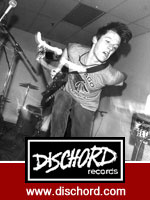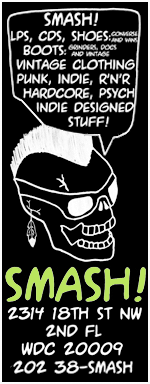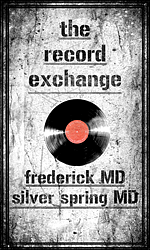

Last week I was introduced to Brad San Martin who runs the tiny record label, Casa Nueva. Our introduction was in advance of next Wednesday’s in-store appearance by Kevin Dunn at Crooked Beat Records. Casa Nueva’s just released “No Great Lost: Songs, 1979-1985” a retrospective of Kevin’s underappreciated (if you ask me) studio recordings.
Brad and I got to talking: “I grew up in Atlanta, and have always been fascinated by the Athens/Atlanta new wave renaissance. One of the unsung pioneers of that scene was Kevin Dunn. Kevin co-founded the first art-rock/new-wave band in the southeast, The Fans, who paved the way for much of what was to come. While the Fans were famously unlucky and broke up with little to show for their efforts , Kevin went on to play in important role in nurturing the scene: he co-produced the B-52s legendary “Rock Lobster” 45 and the first 45 and LP by the incredibly influential Pylon (the album was recently reissued by DFA to widespread acclaim). He also released a series of singles, EPs, and albums of his own brilliantly skewed art-pop that was widely heralded at the time…
When I started my little Casa Nueva label, one of the first things I wanted to do was reissue Kevin’s classic one-man solo debut “The Judgement of Paris,” which had never been on CD. I tracked Kevin down, and we spent the past year getting to know and trust each other, and carefully restoring “Judgement” from the original 16-track tapes, as the stereo master tapes had been destroyed in a fire. The result is “No Great Lost: Songs, 1979-1985,” an anthology of Kevin’s solo work containing all of “The Judgement of Paris” (including one UK-only track), both sides of his legendary “Nadine” 45, choice cuts from the EP and LP that followed “Judgement,” and the a-side of the Fans’ “Cars and Explosions” 45.”
Fitting, it seems, that Kevin’s appearance in DC is at Crooked Beat, as he has quite the affinity for vinyl indeed.
My Plastic Madeleine: Vinyl Considered
by Kevin McFoy Dunn
A declaration contrary (certainly in the instant milieu): many are the reasons for me to covet and to collect vinyl, but — as does witness, empirically and to my entire satisfaction, what I deem the robust testimony of my own œuvre’s vicissitudes — sound does not number among them, in my considered and representably subjective opinion. We can leave it at that.
Much crowds in on me when I set to the recollection of vinyl’s role in my life, the greater part of it pretty random, a congeries of idiosyncratic personal associations and miscellaneous rosters of objects. My copy of Cream’s Goodbye, into which I stapled my ticket stub from their farewell-tour performance at the amphitheatre in Atlanta’s Chastain Park on 27 October 1968. The Stones’ Their Satanic Majesties Request and its terminally kool lo-tech 3-D thingie on the cover’s exterior recto. And, indeed, any cover sheathing music that I liked (and, in a few cases, I confess, that I didn’t, exactly) that also served to herald through obliquity of iconography or recondity of design or both what I was, or wished to be perceived as, as a consumer of the thornily æsthetic (one in this category towards which I feel especial warmth for sound and look marvelously allied: Fred Frith’s Guitar Solos). It at length dawned on me as I was raking through the mental midden that, were I to do this something like right, I would be obliged to aim the instruments of recall back a half-century and more to Merivale Road in Jacksonville, Florida. So here goes.
The recorded music in my childhood house was always my music. Early adopters of the big-time teevee lifestyle of the first third of the Fifties, my parents (father sentimental and unmusical; mother repressedly gifted at certain aspects of jazz pianism but without access to a piano) got their tune exposure mostly from Your Hit Parade (I remember Snooky fucking Lanson, for God’s sake) and its ilk, to an appreciably lesser degree from radio, and not really at all from records — unsurprising, as the only platter-spinning device or devices ever gracing our happy home (it was happy, until I was 9 or 10, anyway) would always be, basically, mine.

And it seems as if I was always in possession of a record player. The first — could I have been as young as three years old? — I eideticize as a flattish brownish box, a piece of necessarily mono junk with a three-inch paper-cone speaker blatting in magnetic sympathy with the jittering graven japa of fond memory (arguably too fond), the memorious furrow tracked by an Iron Age stylus the size of a sewing-machine needle (I have this faint, nagging sense that my father may once have actually tried using one whose blunt end he’d modified with a file) inserted occultly into the business end of a blocky tone arm of dark-beige metal, its weird, child-brain-flummoxing finish halfway between hammered and flaking, its dimensions those of a fat three-month-old’s forearm.
My Ur-records themselves (a cache of which I stumbled across while finally steeling myself to clear out the storage space that housed for a decade and change the pitiful, fraught complement of my deceased mother’s worldly goods) were primitive affairs that may have spun at 78 rpm, punched as they were with small holes. (I say “may have” because no indication of playback speed appears on their labels, and I have no turntable with which to check them out.) To judge from the surviving trove, the collection would have consisted chiefly of, of course, rugrat fare, the oldest exemplars (included software for the unit, I suspect, as their aspect is quite generic) bearing a copyright date of 1953. Christmas material was prominent, as was Disney product (one disc sports tunes from Lady and the Tramp, “Bella Notte” the presumptive A-side) and Terrytoons stuff, those two latter on the Golden Records marque; all of that component of the excavated stash was pressed on avant-le-lettre-’80s-hip colored vinyl (red grapefruit and lemon yellow). I may have had some Melanesian-backcountry-guy sort of intimation about the principle behind the zoetrope, I having drawn in pencil on a Heckle-and-Jeckle-themed production (groove-destroyingly vigorously, natch) stick figures of the chatty magpies menaced at a remove of about 90º by what I take to be a bulbous and, I think, peeved Cartoon Dog of Willendorf. Did I perhaps imagine that spinning them would activate latent animation?

All of these epiphenomena of hearing music don’t sum to hearing music itself; of that ineffability my impressions barely attain to the diaphanous. Some tableaux are retrievable, with lacunæ and shadows. For instance, I remember sitting with Mom and Dad in a cheerily spartan, neon-washed burger joint (not a chain) in Orlando. It would have been 1959, because as I could not then and cannot now resist in-booth jukeboxes, I was burning through some nickels with my selection for the evening, Johnny Horton’s “The Battle of New Orleans,” the which I wheedled my father into playing (doubtless to the consternation of the other patrons) maybe four times in a row, as I found the bit about the gator so goddamned hilarious. (Dad was something of a military history buff, and took the opportunity to fill me in a little on Jackson and Lafitte.) And I remember also — again, it chances, an episode from ’59 — compulsively spinning in my bedroom, as I also spun myself in a Mevlevi-like approximation of grand nineteenth-century ballroom dancing, a 45 of the waltz from Tchiakovsky’s Sleeping Beauty that had been authorizedly or otherwise (that disc didn’t survive time’s wrack, so I can’t say) released in exploitation of the Mouse Empire’s animated feature; transported, I couldn’t stop listening to it. I think that’s when I learned not to stop listening until the beauty is departed.
And that, as a matter of, if nothing else, sheer causal contiguity, is what I owe vinyl: the first intimations of what the intersection of my autonomy and the neural blandishments of moving air governed by that self-moved me could mean. Quondam et futurus, I am suitably grateful.
— Atlanta, 8.ix.2010
Kevin Dunn – Saturn (Mp3)
Approved for download!













